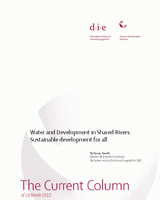Water and Development in Shared Rivers: Sustainable development for all
Tawfik, RawiaThe Current Column (2015)
German Development Institute / Deutsches Institut für Entwicklungspolitik (DIE) (The Current Column of 19 March 2015)
Bonn, 19 March 2015. This year the United Nations selected “Water and Sustainable Development” as a theme for the World Water Day on 22 March. The World Water Day reminds us that there is no human, social and economic development without clean water – from health and sanitation to food, energy production and industrialisation.
Shared Rivers for development: untapping the potential
If countries share rivers development and in particular poverty alleviation in one country must not come at the expense of other countries using the same resource. Riparian states must co-operate to increase and share benefits from the river. Not all countries sharing rivers have been able to equally use this resource to improve the well-being of their people. The current situation along the Nile, the world’s longest river, is a case in point. The Nile flows through eleven countries; namely: Tanzania, Rwanda, Burundi, the Democratic Republic of Congo, Uganda, Kenya, Ethiopia, Eritrea, Southern Sudan, Sudan, and Egypt. Most Nile upstream countries suffer from low levels of human development. The percentage of population without access to electricity ranges from 92 % in Uganda to 77 % in Ethiopia. Up to 72 % of the population in Ethiopia lives on degraded land, compared to 31 % in Kenya and 23 % in Uganda.
To improve these figures and enhance their food and energy production, especially Ethiopia, Sudan and Uganda, have recently launched new hydropower and irrigation projects in the Nile basin. In Ethiopia, which provides 86 % of the Nile waters, 17 dams are either planned or under construction, most of them on shared rivers. The largest of these projects is the Grand Ethiopian Renaissance Dam (GERD) on the Blue Nile. Due for completion in 2017, the dam has an expected capacity of 6,000 MW and will store 74 billion cubic meters.
Ethiopia promotes these projects as vital to achieve its longer term vision of becoming a middle income country by 2020-2023. But the unilateral planning and operation of projects on shared rivers may have negative implications on downstream countries. For instance, an international panel of experts that examined GERD concluded that if filled during dry seasons, the dam may negatively impact the water supply to Egypt and the power generation at the Aswan High Dam. This result alarmed the Egyptian authorities: Egypt depends on the Nile for more than 90 % of its water needs and plans to implement a number of land reclamation and urban resettlements project to recover its economy after four years of instability. It remains to be seen whether the deal that will be signed next Monday between Egypt, Sudan and Ethiopia on GERD, the details of which have not yet been made public, will reduce the negative impacts of the project. However, while criticizing Ethiopia for the unilateral planning of dams on the Nile, Egypt introduced projects and irrigation schemes in the past without consulting other riparian states. Untapping the potential of shared rivers thus requires co-operation to achieve balanced development among riparian states.
Sustainable development for all
Co-operation between riparian states is not only necessary to meet the developmental aspirations of the countries in the shared basin, but also to face common challenges that may reduce the benefits of these countries from the river. According to projections of the United Nations Environment Programme (UNEP), the Nile Basin is expected to become a water-stressed region by 2025, with annual water supplies falling below 1,700 cubic meters per person per year. Moreover, climate change is expected to increase uncertainty about the annual water flow and affect all the sectors that depend on this flow. These prospects should encourage joint efforts to discuss and increase the potential adaptation options. International donors and organisations should create other incentives by providing technical and financial support to joint projects that contribute to long-term development of the river and the riparian states.
